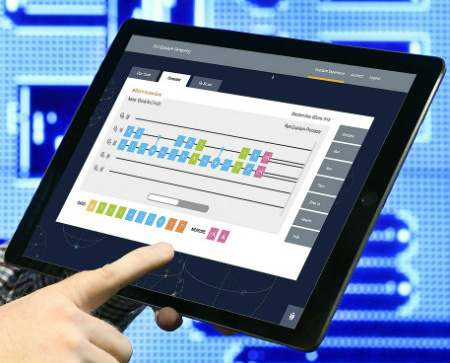By Christine Vu & Gary Thayer
.
Want to shape the future of computing? Now, your inner Super Geek can access a new quantum computing processor from IBM, right from an app on your smartphone or tablet. The idea is to help IBM and other researchers to greatly accelerate current research projects, and also help discover new applications for this technology.
“A universal quantum computer, once built, will represent one of the greatest milestones in the history of information technology,” says IBM Quantum Computing Scientist Jay Gambetta (pictured above). “It has the potential to solve certain problems we will never be able to solve with today’s computers.”
The first-of-a-kind quantum computing platform comes to you via IBM’s cloud service–meaning that you can access it on any desktop or mobile device. The cloud quantum computing platform, called IBM Quantum Experience, lets you run algorithms and experiments on IBM’s quantum processor, work with individual quantum bits called qubits, and explore tutorials and simulations around what might be possible with quantum computing.
 The Quantum Experience project is just part of a larger effort to build a universal quantum computer. IBM’s new quantum processor is composed of five superconducting qubits and is housed at the IBM T.J. Watson Research Center in New York. IBM thinks this qubit architecture can scale to larger quantum systems.
The Quantum Experience project is just part of a larger effort to build a universal quantum computer. IBM’s new quantum processor is composed of five superconducting qubits and is housed at the IBM T.J. Watson Research Center in New York. IBM thinks this qubit architecture can scale to larger quantum systems.
A universal quantum computer could be programmed to perform any computing task. “It would be exponentially faster than classical computers in many important applications for science and business,” says IBM’s Gambetta.
Don’t expect a universal quantum computer anytime soon, but even the “baby steps” will be giant leaps. In the next decade, we’ll likely see medium-sized quantum processors of 50-100 qubits, which will still be extremely powerful, Gambetta predicts.
“With a quantum computer built of just 50 qubits, none of today’s TOP500 supercomputers could successfully emulate it,” he says. “Our community of quantum computer scientists is working to harness this power, and applications in optimization and chemistry will likely be the first to demonstrate quantum speed-up.”
What quantum computing can achieve
“Quantum computers are very different from today’s computers, not only in what they look like and are made of, but more importantly in what they can achieve,” says Arvind Krishna, senior VP and director of IBM Research. “By giving hands-on access to our experimental quantum systems, we will make it easier for researchers and the scientific community to accelerate innovations in the quantum field, and help discover new applications for this technology.”
With Moore’s Law running out of steam, quantum computing will be among the technologies that could usher in a new era of innovation across industries. This big leap forward in computing could create much safer cloud computing systems, search large volumes of big data, and develop new materials to transform industries–such as new [and less overpriced?] pharmaceutical drugs, says Krishna.
“It could also unlock new facets of artificial intelligence, which could lead to future, more powerful technologies for IBM’s Watson,” he says. Watson is a new IBM division dedicated to advancing artificial intelligence applications.
Inside IBM Quantum Experience
Because Quantum information is very fragile, it needs to be protected from any errors that can result from heat and electromagnetic radiation, explains Gambetta. He and other researchers use a “cryogenic dilution refrigerator” to protect the quantum processor’s signals and measure its operations.
He says his quantum team has made a number of engineering advances both at the device level and in the electronic controls to give reliable and high-quality performance in this five-qubit processor. The team then used software from the IBM Cloud platform to create an application that lets IBM Quantum Experience users connect to the quantum hardware from any desktop computer, tablet or smartphone.
The team sees the public introduction of its quantum computing framework as just the start of a new user community, which embraces the quantum world and how it works, says Gambetta.
“In the future, users will have the opportunity to contribute and review their results in the community hosted on the IBM Quantum Experience,” he says. “Also, IBM scientists will be directly engaged to offer more research and insights on new advances.”
IBM plans to add more qubits and different processor arrangements to the IBM Quantum Experience over time, so users can expand their experiments and help uncover new applications for the technology.
Quantum computing – a different way of thinking
We live in a world where classical physics defines our experiences and our intuition, and thus how we process information. But nature at the atomic level is governed by a different set of rules known as quantum mechanics. Because of this, it’s beyond the reach of current non-quantum computers to dig deeper into how quantum mechanics plays a role in in nature–how molecules behave, for example.
Way back in 1981, Richard Feynman proposed to build computers based on the laws of quantum mechanics. It’s taken us over three decades to get there, but it’s finally happening.
It’s taken us so long because quantum computing works in a completely different way from today’s computers. A classical computer makes use of bits to process information, where each bit represents either a one or a zero. In contrast, a qubit can represent a one, a zero, or both at once, which is known as superposition.
This property–along with other quantum effects–enable quantum computers to perform certain calculations vastly faster than is possible with traditional computers.
There are three types of quantum computing and if you’re curious about them, you can see an infographic here. Most of today’s quantum computing research focuses on building a universal quantum computer.
“The major challenges with that are creating qubits of high quality and packaging them together in a scalable way, so they can perform complex calculations in a controllable way, says Gambetta. “We employ superconducting qubits that are made with superconducting metals on a silicon chip. These can be designed and manufactured using standard silicon fabrication techniques.”
Last year, IBM scientists demonstrated important breakthroughs in detecting quantum errors by combining superconducting qubits in latticed arrangements. A latticework quantum circuit design is the only physical architecture that can scale to larger dimensions, says Gambetta.
Now, IBM scientists have advanced further by combining five qubits in the latticework. This demonstrates a key operation known as a parity measurement, which is the basis of many quantum error correction protocols. The road towards universal quantum computing hinges upon achieving quantum error correction, and the IBM team has taken important steps down this path.
Many heads are better than one
“It is a beautiful challenge to pursue the path to build the first universal quantum computer, but it requires us to change how we think about the world,” says Dario Gil, VP of Science and Solutions at IBM Research. “Access to early quantum computing prototypes will be key. If you want to understand what a true quantum computer will do for you and how it works, this is the place to do it. You won’t experience it anywhere else.”
IBM’s quantum computing platform is a core initiative within the newly formed IBM Research Frontiers Institute, a consortium of diverse companies that develops and shares innovative computing technologies. Founding members of the Frontiers Institute include Samsung, JSR, and Honda.
To access the IBM Quantum Experience and for more information on IBM’s quantum computing research, visit ibm.com/quantumcomputing. You can also check out a sedate video of IBM’s quantum computing lab, below. There’s no high-energy pace or soundtrack to it–just high-energy computing.
.





